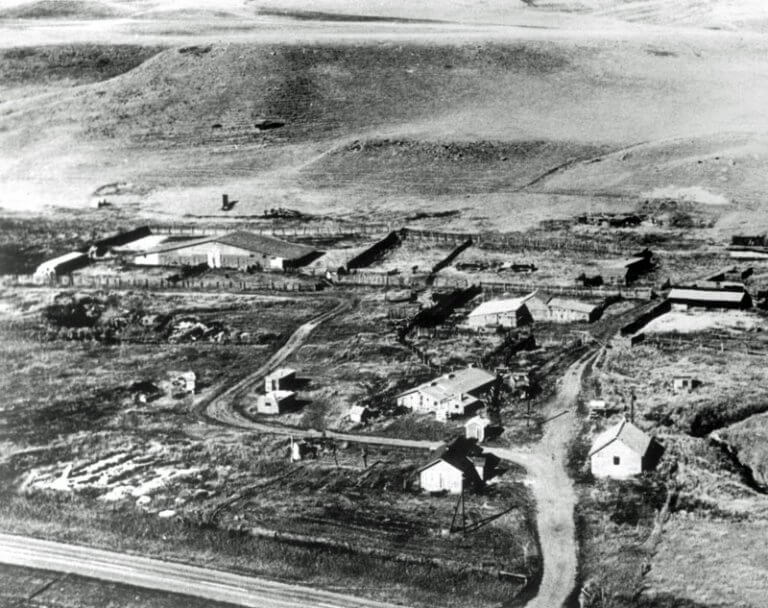from a Collection of Historic Poems and Short Stories by Gordon and Belle Hall Volume II.
It is very interesting to research some of the very early ranchers in Alberta. The Dominion Land Act of 1872 opened up the west to homesteaders. The north immediately began to settle. However, due to Blackfoot hostility, the area south of the Bow River remained empty of white men [sic] except for a few traders and “Wolfers” from south of the border. The first fort at Spitze (High River) was built by the whiskey trader “One Spot’ Samples in 1865.
With the coming of the North West Mounted Police in 1874, things quieted down, the whiskey traders were muzzled. However, the area was not safe for settlers until after the signing of the Treaty of 1877 which put the Blackfoot on reservations [sic]. In 1879 Tom Lynch and George Emerson trailed 1,000 head of cattle from Montana and established the Rocking P Ranch four miles west of High River. About the same time, O.H. Smith established a ranch on the upper Highwood. In 1882 he sold it to Fred Ings. The next year Stimson started the Bar U. Although Fred Ings and his brother Walter named their spread the Rio Alta Ranch almost a century later it was still known locally as O.H. brand was one of the first four brands registered and is the oldest brand in Alberta. During the early eighties, thousands of head of cattle and horses were trailed from the States. Crossed with British bulls, those tough Longhorns formed the foundations of Alberta’s cattle industry. As the railroad pushed westward the government encouraged settlement.
The Cochrane Ranche Co. was formed sometime prior to 1881. Their headquarters was one mile west of the present town of Cochrane, with the present boundaries the site is closer than one mile. In the spring of 1881 Major Walker went to the States and purchased 6,800 head of cattle at a price of $18 per head, to be delivered at the border. The I.G. Baker Co. contracted to deliver the cattle to the Cochrane Ranche for $2,50 per head. The drive consisted of 30 cowboys, and 300 head of horses. Arriving at Cochrane Ranche after a hard drive on which many of the cattle perished, and although it was a mild winter, many more cattle perished. A second herd was brought up from the States the following year. Poindexter and Orr undertook to deliver the new herd to the Cochrane Ranche at $2.75 a head. The winter of 1882-83 was a disaster for Cochrane Ranche and thousands of cattle died, due mainly to the chinook winds which put a crust on the snow, and the fact that the new herd arrived here late in October after the winter had started. The following year, 1884, the Ranche was moved to a new location near Waterton Lakes.
Digitally Preserving Alberta’s Diverse Cultural Heritage has a very interesting article on the history and research done on the site and includes the above photo of the Ranche Site.



Very interesting article and the link to the digital preservation site is also very informative. Will the upcoming construction of the 1A/Hwy 22 interchange further impact this historical site? Perhaps a more precise description of where the original Cochrane Ranche buildings were located will help me picture how this looked in historical times.
The original ranch house and bunkhouse are against the hill. The remainder of the buildings I’m not sure of. They may have been built by the Gilbert’s who had the place when I was growing up. The site is west of the current museum. You can see the creek bend.
Thanks Mark! So, more or less in the area where the log cabin is now located…maybe a bit farther west. Will the new interchange construction affect this site?
Hi Mark, I remember the remainder of the old barn when I was growing up. We had our horses on the Cochrane Ranch when the Gilbert’s still owned it. I was just discussing with my brother George Waldern how we recalled Mom chasing some boys up over the hill because they were hanging gofers from the rafters of the barn.
We lived on the south side of the tracks by the rodeo grounds. Hardly any buildings over there at that time except the trailer court, rodeo grounds and the mill.
Boy the name Boothby sure sounds familiar.
It’s been nice reminiscing, Rose (Waldern) Vaterlechner